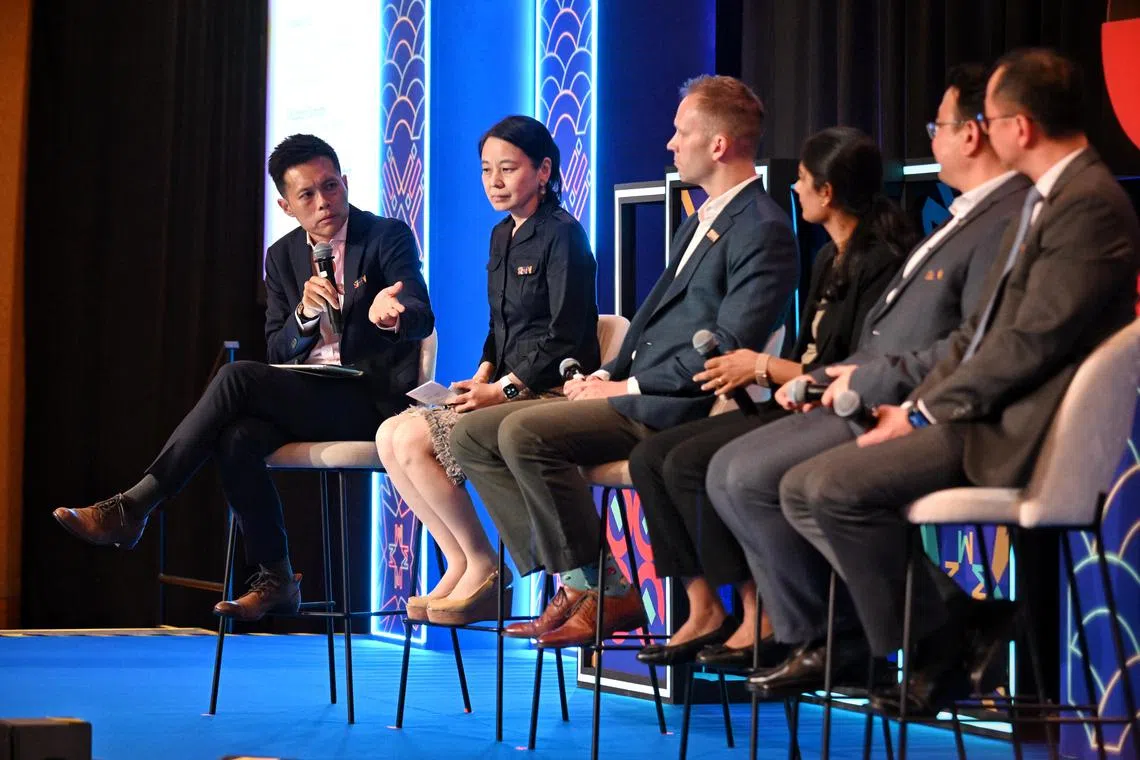EV owners selling electricity back to S’pore power grid? Possible, but challenging, says expert panel
Sign up now: Get ST's newsletters delivered to your inbox

ST senior transport correspondent Lee Nian Tjoe (left) moderating the Singapore International Energy Week panel discussion on electric mobility on Oct 24.
ST PHOTO: KUA CHEE SIONG
Follow topic:
SINGAPORE – The possibility of electric vehicles (EVs) pumping energy back into Singapore’s power grid opens new avenues for better energy management and sustainability, and was a topic of enthusiastic discussion by a panel of experts on Oct 24.
Vehicle-to-grid systems, which are being explored here, enable EV owners to sell energy to the grid.
This is useful to meet energy demand during peak hours, or when there are disruptions to the power supply.
For instance, 16 EVs successfully discharged their batteries to send power back into the grid sixty seconds after a storm shut down Victoria’s largest power station in a recent trial in Australia, said Dr Dhivya Sampath Kumar, a researcher focused on smart grid management and grid security.
The assistant professor at the Singapore Institute of Technology (SIT) was part of the Singapore International Energy Week panel discussion on electric mobility, moderated by senior transport correspondent Lee Nian Tjoe from The Straits Times.
Dr Sampath Kumar said EVs could “help” the power grid by undergoing charging during off-peak times and discharging electricity during peak timings.
And with even newer developing technologies, EV batteries can become flexible energy resources that can be plugged into various places, such as in buildings and homes, to transfer electricity to the grid, she added.
Vehicle-to-grid systems could also support Singapore’s move towards more renewable energy, said Mr Douglas Duncan, head of strategic development at energy storage systems manufacturer Durapower Group.
He highlighted the Republic’s goal of achieving at least 2 gigawatt-peak of solar energy deployment by 2030. As the sun does not shine all the time, more grid support solutions would be required to stabilise the power supply.
Vehicle-to-grid technology is relatively nascent, and is being trialled or studied in various countries.
Dr Sampath Kumar said SIT is working with Strides, the commercial arm of public transport operator SMRT, on a vehicle-to-grid test bed to evaluate the technical and commercial feasibility of such systems. This is funded by a grant from the Energy Market Authority.
But there are challenges that must be overcome for the system to become a reality here, panellists said.
For one thing, all 13,800 registered EV charging points in Singapore would have to be overhauled to participate in the system, said Mr Dean Cher, head of SP Mobility, a subsidiary of utilities company SP Group. This is because the vehicle-to-grid system requires bidirectional chargers that can push and pull energy to and from EVs based on the demand for power at any given time.
Furthermore, the batteries required for such a system are “totally different” from the existing ones, said Mr Alex Bao, head of the South-east Asia region at Chinese luxury EV brand Zeekr. But some brands may start looking into cars that can be adapted for vehicle-to-grid use in the near future, he added.
Mr Duncan also noted that EV owners may be concerned about what the system could do to their EV batteries, as the lifespan of the battery would decrease with every charge or discharge, and this may lead to maintenance issues.
A possible solution, he said, is to adopt battery leasing, where suppliers would guarantee the availability and longevity of these batteries. This would lower EV owners’ costs of ownership, and encourage them to participate in the vehicle-to-grid system without worrying about the battery lifespans.
A new market structure is also needed, added Mr Cher, as EV owners would have to be compensated when they plug into the vehicle-to-grid system, compared with the current arrangement of them paying to charge their cars.
Under such systems, EV owners would be able to customise the time for and volume of the energy to be discharged, and could receive direct payments or credits, reducing their electricity bills in the long run.
Mr Duncan said that it may not be possible for private users to sell electricity directly back to the grid, and suggested instead the creation of a middleman company that could aggregate a supply of batteries to provide power for the grid whenever required.
Correction note: In an earlier version of the story, we said that 16 EVs discharged their batteries to send power back to the grid within six seconds, instead of sixty seconds. This has been corrected.

